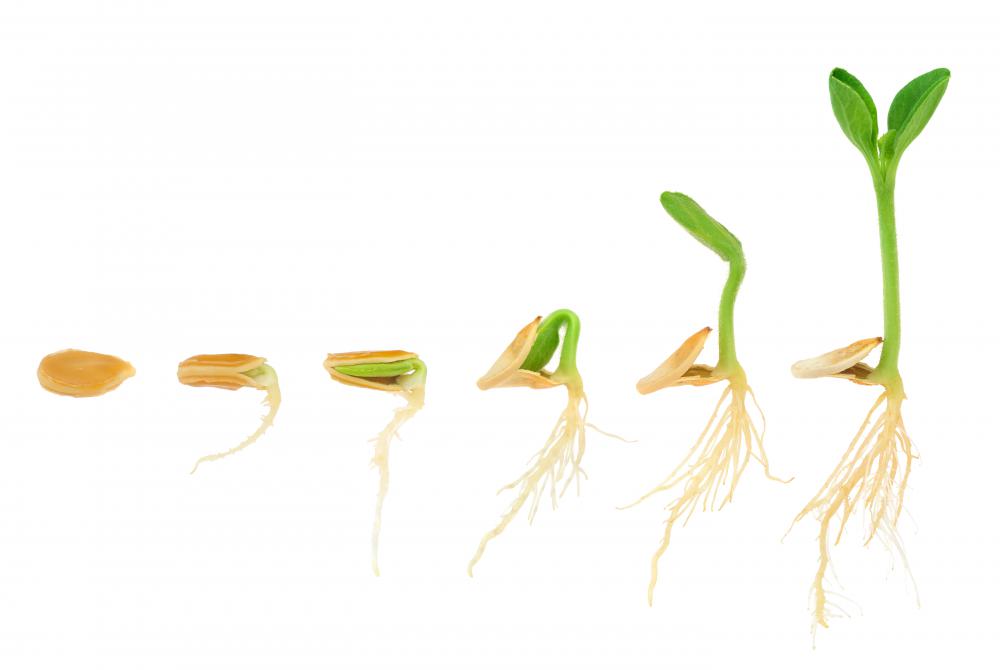At HomeQuestionsAnswered, we're committed to delivering accurate, trustworthy information. Our expert-authored content is rigorously fact-checked and sourced from credible authorities. Discover how we uphold the highest standards in providing you with reliable knowledge.
What does It Mean if a Plant is Self-Seeding?
When a plant is self-seeding, it means that it produces seeds which can be collected or allowed to fall to the ground and replant themselves in that location. These seeds germinate during the fall and lie dormant during the winter months. They being to sprout and grow at the start of the growing season, at the end of which new seeds are produced and begin the cycle over again. This trait is found in different varieties of flower, shrub, herb, tree, and vegetable.
Self-seeding plants are typically annuals, though some few varieties of perennials also have this trait. An annual is a flower or shrub that grows from one individual seed and dies at the end of the growing season. The plant can produce mature seeds while it flowers and grows which are of the same type, but represent a second generation. These next generation seeds may fall to the ground or be carried to another part of the garden by pollinators, like bees and pets, to germinate and grow the following season. Some perennials grow from bulbs, and the same plant remains dormant during the cold months so that it may bloom and grow again every spring.

Gardens that are filled with self-seeding plants tend to bloom again at the start of each spring growing season without the assistance of a gardener. No additional seedlings need to be planted for flowers and shrubs to reappear. Pollination and germination typically occur during the fall season, allowing seeds and roots to remain dormant during the winter and store up nutrients that will be used for foliage growth when temperatures begin to warm again.

These plants also prefer natural soil over highly cultivated flower beds. Natural soil reflects the conditions of the land in which the seeds are planted, whether acidic or alkaline. Soil may be rocky, sandy, or clay, depending on the local growing zone. Self-seeding plants do not flourish well when exposed to compost or soil additives, which tend to incorporate large amounts of nitrogen, phosphorous, and potassium into the mixture and balance the soil's pH. They require very little water and prefer full to partial sun during the day time.
The seeds from a self-seeding plant may be collected by a gardener or allowed to fall and plant themselves. When a gardener collects these seeds, she should typically wait until the flower has begun to dry and deaden. She may then clip the head from the plant, cut it into small strips, and store it in a cool and dry location until she is ready to scatter it in a new part of the garden or lawn. Seeds that are allowed to fall to the ground will simply sprout where they land and grow in that location the following year. This type of scenario, also known as naturalizing, is ideal for those who prefer a low maintenance garden or wildflower patch that continuously plants itself year after year.
AS FEATURED ON:
AS FEATURED ON:












Discussion Comments
@pastanaga - Some plants are great self seeders, but you do have to be careful about getting that type of plant in the first place. Tomatoes, for example, will often grow from seed if you let them, but if the seeds come from hybrid plants the seedlings might end up without the qualities of their parents.
@KoiwiGal - It's not that difficult to collect and store seed once you understand how for each plant. I would collect coriander seed every year when I had a big herb garden and then I would use some of it in the kitchen and some of it would go back into the garden in the next year.
Self seeding plants in a herb garden are great as long as you aren't too rigid about where you want each plant to go. Although, really, even if you do have a preference for placement, you can just transplant the seedlings before they get too settled in one place.
And it's much cheaper to get an endless supply of plants growing from seed the way they are supposed to, rather than needing to get them from the garden store every year.
Typically, you aren't going to want many plants in your garden that are self seeding. Most of the time people buy plants that are intended for a particular place at a particular time. If they self seed, you don't get to choose the place or the time that the new plants come up, unless you collect the seed yourself.
Grass and wildflowers and plants that are meant to grow somewhat wild are fine as self seeders, but in my experience they rarely get it completely right without needing a bit of extra seed added every couple of years.
Post your comments